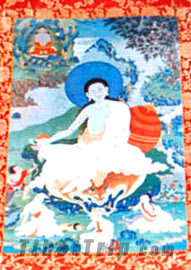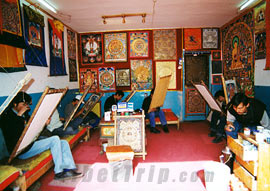 A brief introduction
A brief introduction
A thangka is an exquisite scroll painting consisting of a picture panel either painted or embroidered, a textile mounted together with some ornamental and functional accessories. The former thangka is the most common type found in monasteries and family alters, which is usually 75 centimeters (30 inches) long and 50 centimeters (20 inches) wide. However a thangka which is 55.80 meters (183 feet) high and 46.81 meters (154 feet) wide can be found in Potala Palace.

The most eye-catching part should be the painting panel on which are depicted a wide range of subjects including Tibetan history, folklores, fairy tales, geography, chronometer, medicine, humans and lucky designs etc., among which the images of Buddha, deity and Bodhisattva are the most common ones. The iconographic information conveyed in the picture is extraordinarily rich and florid. There are many deities depicted in various postures and expressions together with different surroundings making a thangka changeable in form and rich in style.
On the basis of material used and techniques involved, thangkas can be divided in to two groups: those that are painted on cloth, silk and paper; and those that are made of silk either by weaving or with embroidery or appliques.
 The history and development
The history and development
Thangka plays a very important role in the history and development of Tibetan paintings. According to historical materials, the origin and development of thangka painting accompanied the evolution of Buddhism in Tibet. It is said that the first thangka appeared as early as 1,000 years ago. The painting which is convenient for carrying and collecting came into shape then, and was very popular among the nomadic people. At the end of the tenth century, Buddhism experienced a thriving era again after a period of time when Buddhism was in the doldrums. Since then thangka's have taken big strides in their development and come into a prosperous era. Painters with superb techniques have enjoyed great popularity which enabled the thangka to reach its peak during the Ming Dynasty (1368-1644) and the Qing Dynasty (1644-1911), and consequently different genres with distinctive painting styles appeared.
 The creation of thangkas
The creation of thangkas
Being a unique art genre only found in Tibet, the creation of thangkas is quite complicated, subtle and also requires different techniques and training skills. The process of making a thangka follows a precise set of rules that are considered sacred. After a proper cotton canvas is selected, each side of the cloth is stitched onto a wooden stick. Then the cloth is stretched over a wooden frame in order to create a smooth and flat surface. After setting up the cloth, a mixture made of glue and talcum powder is brushed evenly on both the front and back of the cloth. Then the cloth is removed to a flat position where it is thoroughly dried. Then using a shell or a round stone burnish on the both sides until the lines of the cloth are indescribable and the cloth looks and feels smooth and lustrous.

Now, it is ready for painting. Contour lines are drawn with charcoal or graphite, and then the surrounding elements of the composition are outlined right after the principle person is outlined. The subsequent procedure, applying of colors, follows a certain process. Note that the dyes are all made of minerals and added animals' bile to prevent it from rotting. So the colors can keep bright through the ages. The painters start from the outer areas setting around the central person such as sky, clouds, subordinate and attendants. Then the Lotus seat is colored before the body of the central figure. Then finally the eyes of the Buddha are painted to bring the deity to life.
Another important procedure is the mounting of the picture. The cloth with picture is then bordered in red and mounted on a bigger piece of blue brocade or silk. Two narrow sticks are then attached on the top and bottom of the scroll so that it can easily be rolled up. Two red ribbons are then hung along the scroll frame. And you can also see a piece of satin rolled up at the top that is used as a cover for when the thangka is not being displayed. So from all the details that are previously mentioned we know that thangkas are a unique art form that are not merely a painting but a three-dimensional object.
Thangkas have long been treasured and highly prized because of their close connection with religions and unique art style. They can virtually be regarded as a historical recording of the evolution of Tibetan civilization.








